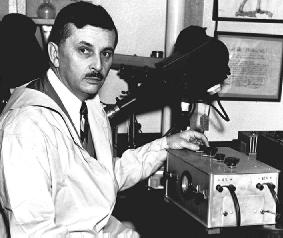Harold Saxton Burr facts for kids
Quick facts for kids
Harold Saxton Burr
|
|
|---|---|

H.S. Burr
|
|
| Born | April 18, 1889 |
| Died | February 17, 1973 |
| Occupation | Researcher and teacher of neuroanatomy and bioelectrodynamics |
Harold Saxton Burr (born April 18, 1889 – died February 17, 1973) was a well-known professor at the Yale University School of Medicine. He was a researcher who studied how electricity works in living things, a field called bio-electrics.
Contents
Early Life and Education
Harold Saxton Burr was born in Lowell, Massachusetts, in 1889. His parents were Hanford and Clara Burr. He went to public schools and then to Technical High School in Springfield, Massachusetts.
In 1908, he started studying at the Sheffield Scientific School at Yale University. He earned his first degree, a Ph.B., in 1911. Later that year, he married Jean Chandler, and they had a son named Peter.
In 1914, he became an Instructor in Anatomy at Yale. He continued his studies and earned his Ph.D. in 1915. He taught at Yale for many years, becoming a full Professor in 1929. He stayed at Yale until he retired in 1958.
Studying Life's Electricity
From 1916 to 1956, Professor Burr wrote many scientific papers. Early in his career, he focused on how the nervous system and other parts of the body develop. He often studied creatures like salamander larvae.
The Electro-Dynamic Theory
In 1932, Burr noticed something interesting while studying salamanders. He suggested that living things have an "Electro-Dynamic Theory of Development." This idea is what he is most remembered for today.
In 1935, he published more papers about this theory. One was called "The Electro-Dynamic Theory of Life." He also wrote about "Electrical Characteristics of Living Systems."
Measuring Life's Fields
Burr was known for using a special tool called a voltmeter. This tool helps measure the tiny amounts of electricity in living bodies. He first wrote about this in 1936.
He came up with the term "L-Field" to describe these electric fields in living things. He believed these fields were very important.
In 1942, Burr even measured the electric current coming from growing corn plants. He said that "electricity seems to bridge the gap between the lifeless world and living matter." This meant he thought electricity was a basic part of all living things, just like it is in the non-living world.
Impact of His Research
Burr's research helped in several areas:
- Detecting illness: He studied how electricity could help find cancer cells.
- How living things grow: His work helped understand how embryos develop.
- Nervous system: He learned more about how the nervous system forms and repairs itself.
His studies on the electricity related to body cycles in women helped create devices that could indicate fertility. He also spent many years studying the electricity in trees. He found that the electric fields in trees changed with the daily cycle, the moon's cycle, and the yearly seasons.
His Books and Ideas
In 1962, Burr wrote a book called The Nature of Man and the Meaning of Existence. In this book, he shared his ideas about the universe and life. He believed there was order in the universe and that living things had a special unity.
His book Blueprint for Immortality, published in 1972, talked more about his "L-Fields." He claimed that these electric fields in all living things could be measured. He believed they guided how an organism develops, its health, and even its mood. He called these "fields of life."
Burr's ideas about L-fields were similar to other theories, like the "morphogenetic field" proposed by other scientists. He used the L-field to explain how cells become different types and how living organisms get their shape. While his ideas were interesting, many scientists did not agree with his full theory. However, his research was continued by Leonard J. Ravitz, who had worked with him.
Hobbies and Interests
Outside of his scientific work, Harold Saxton Burr was a talented amateur painter. He loved painting waterscapes and landscapes. His early paintings were influenced by his friend George Bruestle. Later, he started using pastels more often, and his paintings became more abstract. He showed his artwork at various art associations and clubs from the 1920s to the 1940s.
See also
- Electroencephalography
- Electrocardiogram
- Morphogenetic field

